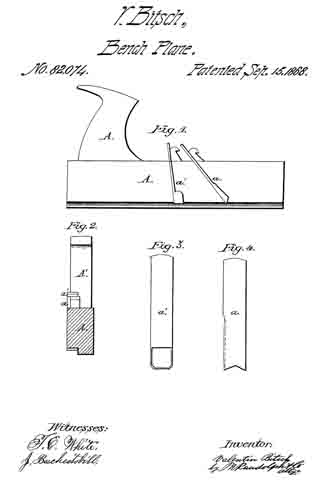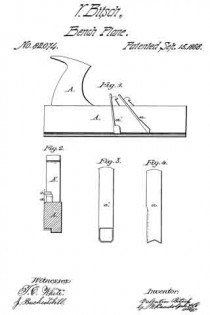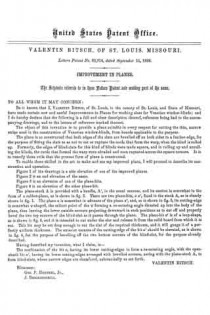
| PLEASE NOTE: The images presented on this page are of low resolution and, as a result, will not print out very well. If you wish to have higher resolution files then you may purchase them for only $2.95 per patent by using the "Buy Now" button below. All purchases are via PayPal. These files have all been cleaned up and digitally enhanced and are therefore suitable for printing, publication or framing. Each zip package contains all the images below (some packages may contain more), and purchased files can be downloaded immediately. |
United States Patent Office.
VALENTIN BITSCH, OF ST. LOUIS, MISSOURI.
Letters Patent No. 82,074, dated September 15, 1868.
_________________
IMPROVEMENT IN PLANES.
_________________
The Schedule referred to on these Letters Patent and making part of the same.
_________________
TO ALL WHOM IT MAY CONCERN:
Be it known that I, VALENTIN BITSCH, of St. Louis, in the county of St. Louis, and State of Missouri, have made certain new and useful Improvements in Planes for working slats for Venetian window-blinds; and I do hereby declare that the following is a full and clear description thereof, reference being had to the accompanying drawings, and to the letters of reference marked thereon.
The object of this invention is to provide a plane suitable in every respect for cutting the thin, narrow strips used in the construction of Venetian window-blinds, from boards applicable to the purpose.
The plane is so constructed that both edges of the slats are bevelled off on both sides to a feather-edge, for the purpose of fitting the slats so as not to cut or rupture the cords that form the warp, when the blind is rolled up. Formerly, the edges of blind-slats for this kind of blinds were made square, and in rolling up and unrolling the blinds, the cords that formed the warp were abraded and soon ruptured across the square corners. It is to remedy these evils that the present form of plane is constructed.
To enable those skilled in the art to make and use my improved plane, I will proceed to describe its construction and operation.
Figure 1 of the drawings is a side elevation of one of the improved planes.
Figure 2 is an end elevation of the same.
Figure 3 is an elevation of one of the plane-bits.
Figure 4 is an elevation of the other plane-bit.
The plane-stock A is provided with a handle, A’, in the usual manner, and its section is somewhat in the form of a rabbet-plane, as is shown in fig. 2. There are two plane-bits, a a’, fixed in the stock A, as is clearly shown in fig. 1. The plane a is somewhat in advance of the plane a’, and, as is shown in fig. 3, its cutting-edge is somewhat V-shaped, the salient point of the V forming a re-entering angle directed up into the body of the plane, thus leaving the lower outside corners projecting downward in such positions as to cut off and properly bevel the two top corners of the blind-slat as it passes through the plane. The plane-bit a’ is of a loop-shape, as is shown in fig. 4, and it is intended to cut under the slat and release it from the solid board from which it is cut. This bit may be set deep enough to cut the slat of the required thickness, and it will gauge it of a perfectly uniform thickness. The exterior corners of the cutting-edge of the bit a’ should be elevated, as is shown in fig. 4, for the purpose of bevelling off the two bottom corners of the blind-slat, for the purpose already described.
Having described my invention, what I claim, is —
The combination of the bit a, having its lower cutting-edges to form a re-entering angle, with the open-shank bit a’, having its lower cutting-edges arranged with bevelled corners, acting with the plane-stock A, to form blind-slats, whose narrow edges are chamfered, substantially as set forth.
VALENTIN BITSCH.
Witnesses:
GEO. P. HERTHEL, Jr.,
J. BESCHESTOBILL.


